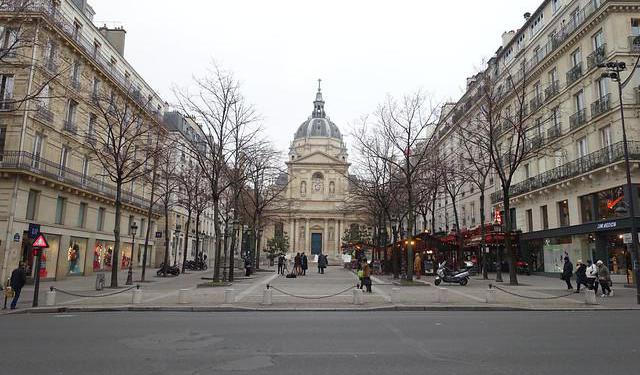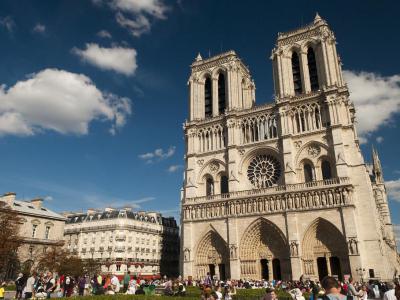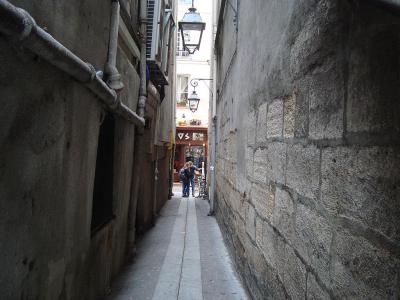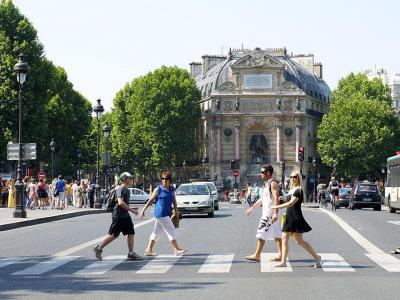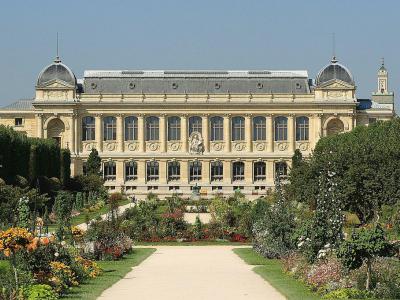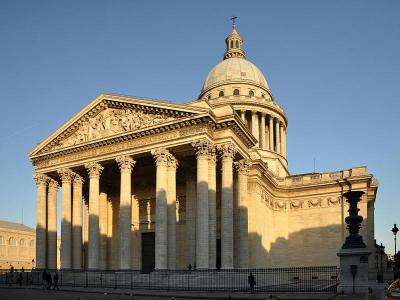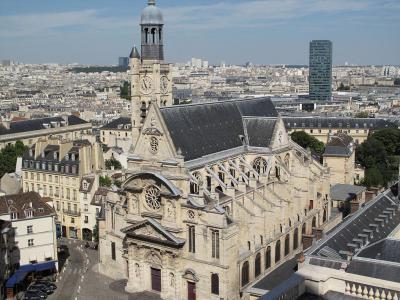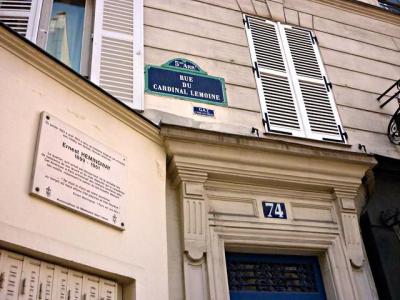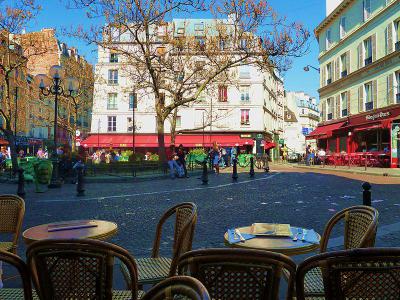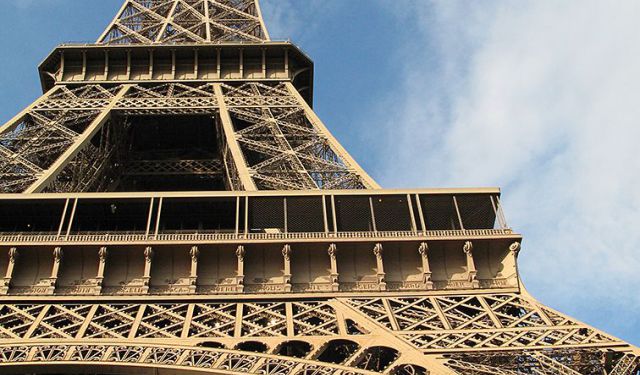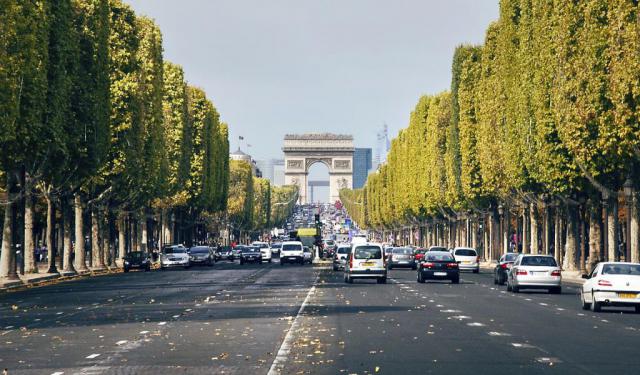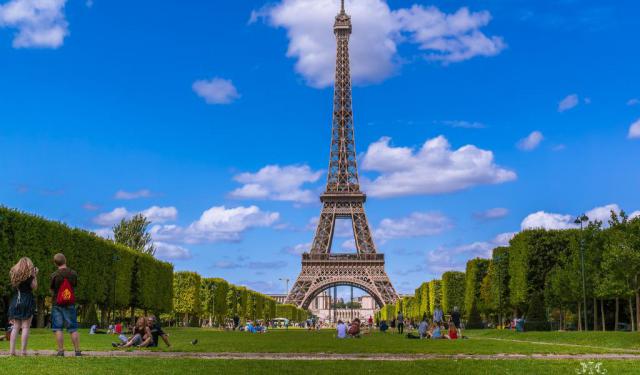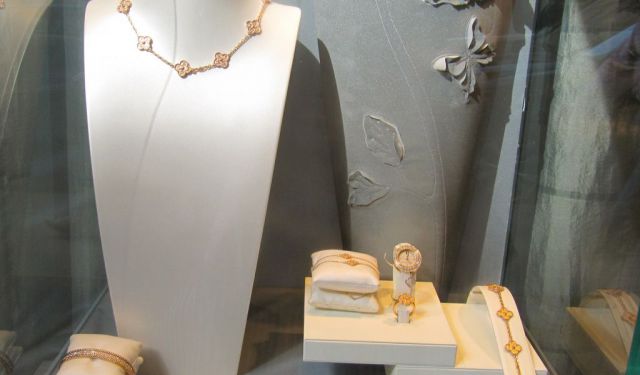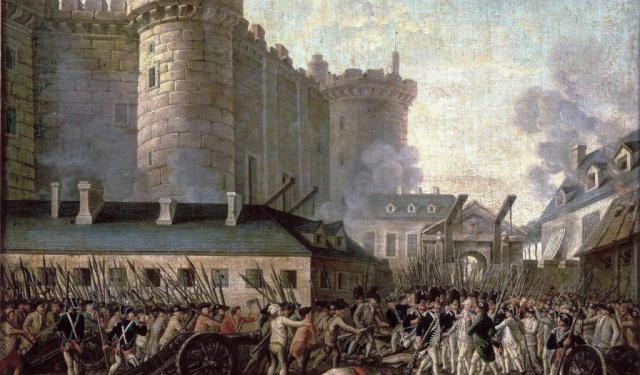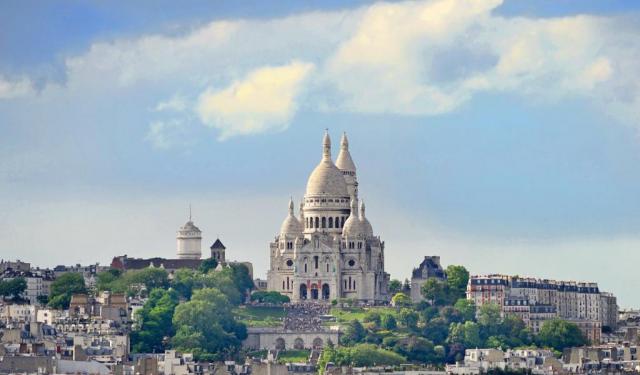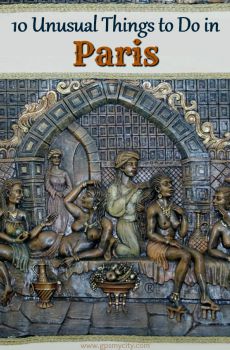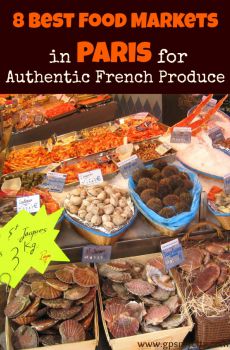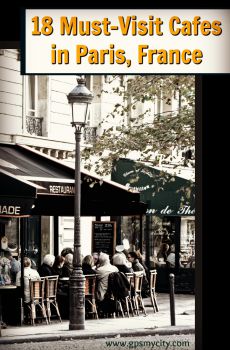Audio Guide: Latin Quarter Walking Tour (Self Guided), Paris
The Latin Quarter of Paris, nestled on the Left Bank of the Seine, is a district steeped in academic history and artistic fervor, resonating with the echoes of scholarly discourse and bohemian lifestyle. This venerable area derives its name from the early use of Latin as the lingua franca in the universities, a tradition spearheaded by the Sorbonne University. This institution has shaped intellectual life by educating bright young minds since the 13th century.
The Latin Quarter is still very lively, with a friendly village feel, graced with beautiful fountains and trees, as well as a clutch of outstanding historical sites. At the heart of it, the Notre-Dame Cathedral stands as an emblem of Gothic architecture, though it is currently under restoration from the 2019 fire. Nearby, just across the bridge, literary enthusiasts find solace in Shakespeare & Company, an iconic bookstore that has long been a sanctuary for writers. For those pursuing quaint Parisian charm, Fishing Cat Street offers a glimpse into medieval Paris as the narrowest street in the city.
Spiritual heritage in the quarter is rich, with the lovely historic Church of Saint Julian the Poor, one of the oldest in Paris, and the splendid Saint-Severin Church, known for its stunning stained glass and intricate stonework. Public squares like Saint Michael's Square with its vibrant fountain, and Contrescarpe Square, known for its lively atmosphere, provide welcoming spaces to watch people and get your bearings.
For higher cultural diversions in the quarter, visit the Cluny Museum (also known as the National Museum of the Middle Ages) where medieval art, including the famed tapestries of "The Lady and the Unicorn", are displayed. Just outside of the immediate neighborhood, up the hill, the majestic Panthéon serves as a mausoleum for distinguished French personalities. At the same time, the Church of Saint-Etienne-du-Mont houses the shrine of Saint Geneviève, the patron saint of Paris.
And of course, no lover of Hemingway’s books will find a walk through the Latin Quarter complete without a visit to Cardinal Lemoine Street. Here, the author’s apartment on the upper floor of the House of Verlaine still stands as a beacon for aspiring writers and fans alike.
For those drawn to the allure of history, art, and culture, the Latin Quarter offers an unparalleled journey into the heart of Parisian life. Engage with the past, revel in the present, and take inspiration from the enduring spirit of this historic area. Whether you are a scholar, a dreamer, or simply a curious traveler, the Latin Quarter of Paris awaits to share its stories with you!
The Latin Quarter is still very lively, with a friendly village feel, graced with beautiful fountains and trees, as well as a clutch of outstanding historical sites. At the heart of it, the Notre-Dame Cathedral stands as an emblem of Gothic architecture, though it is currently under restoration from the 2019 fire. Nearby, just across the bridge, literary enthusiasts find solace in Shakespeare & Company, an iconic bookstore that has long been a sanctuary for writers. For those pursuing quaint Parisian charm, Fishing Cat Street offers a glimpse into medieval Paris as the narrowest street in the city.
Spiritual heritage in the quarter is rich, with the lovely historic Church of Saint Julian the Poor, one of the oldest in Paris, and the splendid Saint-Severin Church, known for its stunning stained glass and intricate stonework. Public squares like Saint Michael's Square with its vibrant fountain, and Contrescarpe Square, known for its lively atmosphere, provide welcoming spaces to watch people and get your bearings.
For higher cultural diversions in the quarter, visit the Cluny Museum (also known as the National Museum of the Middle Ages) where medieval art, including the famed tapestries of "The Lady and the Unicorn", are displayed. Just outside of the immediate neighborhood, up the hill, the majestic Panthéon serves as a mausoleum for distinguished French personalities. At the same time, the Church of Saint-Etienne-du-Mont houses the shrine of Saint Geneviève, the patron saint of Paris.
And of course, no lover of Hemingway’s books will find a walk through the Latin Quarter complete without a visit to Cardinal Lemoine Street. Here, the author’s apartment on the upper floor of the House of Verlaine still stands as a beacon for aspiring writers and fans alike.
For those drawn to the allure of history, art, and culture, the Latin Quarter offers an unparalleled journey into the heart of Parisian life. Engage with the past, revel in the present, and take inspiration from the enduring spirit of this historic area. Whether you are a scholar, a dreamer, or simply a curious traveler, the Latin Quarter of Paris awaits to share its stories with you!
How it works: Download the app "GPSmyCity: Walks in 1K+ Cities" from Apple App Store or Google Play Store to your mobile phone or tablet. The app turns your mobile device into a personal tour guide and its built-in GPS navigation functions guide you from one tour stop to next. The app works offline, so no data plan is needed when traveling abroad.
Latin Quarter Walking Tour Map
Guide Name: Latin Quarter Walking Tour
Guide Location: France » Paris (See other walking tours in Paris)
Guide Type: Self-guided Walking Tour (Sightseeing)
# of Attractions: 12
Tour Duration: 2 Hour(s)
Travel Distance: 2.5 Km or 1.6 Miles
Author: DanaOffice
Sight(s) Featured in This Guide:
Guide Location: France » Paris (See other walking tours in Paris)
Guide Type: Self-guided Walking Tour (Sightseeing)
# of Attractions: 12
Tour Duration: 2 Hour(s)
Travel Distance: 2.5 Km or 1.6 Miles
Author: DanaOffice
Sight(s) Featured in This Guide:
- Cathedrale Notre-Dame (Notre-Dame Cathedral)
- Shakespeare & Company
- Rue du Chat-qui-Peche (Street of the Fishing Cat) – Narrowest street in Paris
- Eglise Saint-Julien-le-Pauvre (Church of Saint Julian the Poor)
- Eglise Saint-Severin (Church of St. Severin)
- Place Saint-Michel (St Michael's Square)
- Musee de Cluny (National Museum of the Middle Ages)
- Sorbonne Universite (The Sorbonne)
- Pantheon
- Eglise Saint-Etienne-du-Mont (Church of Saint-Etienne-du-Mont)
- Rue du Cardinal Lemoine - Hemingway's Apartment
- Place de la Contrescarpe (Contrescarpe Square)
1) Cathedrale Notre-Dame (Notre-Dame Cathedral) (must see)
While the Eiffel Tower is an instantly recognizable symbol of France, the Notre-Dame Cathedral is an unmistakable symbol of Paris. Notre-Dame de Paris, or "Our Lady of Paris," is a medieval Catholic church renowned for its French Gothic appearance. Among other features, this cathedral showcases period architectural innovations such as the rib vault and flying buttress, as well as large rose windows and rich sculptural decoration. Notre-Dame’s architectural and historical significance is underscored by its vast pipe organs, iconic bells, and its role in hosting significant ceremonies like Napoleon’s coronation, the celebration of the Liberation of Paris in 1944, and the funerals of presidents Charles de Gaulle and François Mitterrand.
Before Notre-Dame, a temple to Jupiter and later a cathedral dedicated to Saint Étienne occupied the site. Construction of Notre-Dame began in 1163 and concluded in 1260, incorporating architectural advancements in four major stages, with additions in the 13th century enhancing stability and light. At the time of its construction, it was the most ambitious cathedral project ever undertaken in France, its vaults rising over 33 meters and holding a national height record for several decades.
In 1431, Notre-Dame saw the coronation of King Henry VI, and during the French Revolution, suffered vandalism when it was repurposed as a warehouse. In the 19th century, Victor Hugo’s novel, The Hunchback of Notre-Dame, spurred its restoration, largely preserving Notre-Dame’s legacy.
Amid the Second World War, upon the Fall of France, there were fears that the German invaders might destroy the freshly renovated stained glass of the rose window. As a result, the lion's portion of it was hidden and re-installed only after the war.
In 2019, a fire severely damaged the cathedral's oak roof and spire. Firefighters saved much of the building, including the world's biggest 13th-century glass window and other artifacts and relics which were temporarily removed for safety. Though many decorations have been removed over time, the cathedral retains Gothic, Baroque, and 19th-century sculptures, altarpieces, and revered relics, including the Crown of Thorns and fragments from the True Cross.
As a symbol of Paris and France, Notre-Dame is renowned for its traditional Lent sermons since the 1830s and attracts annually around 12 million visitors.
Before Notre-Dame, a temple to Jupiter and later a cathedral dedicated to Saint Étienne occupied the site. Construction of Notre-Dame began in 1163 and concluded in 1260, incorporating architectural advancements in four major stages, with additions in the 13th century enhancing stability and light. At the time of its construction, it was the most ambitious cathedral project ever undertaken in France, its vaults rising over 33 meters and holding a national height record for several decades.
In 1431, Notre-Dame saw the coronation of King Henry VI, and during the French Revolution, suffered vandalism when it was repurposed as a warehouse. In the 19th century, Victor Hugo’s novel, The Hunchback of Notre-Dame, spurred its restoration, largely preserving Notre-Dame’s legacy.
Amid the Second World War, upon the Fall of France, there were fears that the German invaders might destroy the freshly renovated stained glass of the rose window. As a result, the lion's portion of it was hidden and re-installed only after the war.
In 2019, a fire severely damaged the cathedral's oak roof and spire. Firefighters saved much of the building, including the world's biggest 13th-century glass window and other artifacts and relics which were temporarily removed for safety. Though many decorations have been removed over time, the cathedral retains Gothic, Baroque, and 19th-century sculptures, altarpieces, and revered relics, including the Crown of Thorns and fragments from the True Cross.
As a symbol of Paris and France, Notre-Dame is renowned for its traditional Lent sermons since the 1830s and attracts annually around 12 million visitors.
2) Shakespeare & Company
Shakespeare and Company, an English-language bookstore in Paris, offers an excellent choice of new, second-hand, and antiquarian books of various genres and periods. Whether you want to stock up on study materials, seek the latest titles from the British press, or perhaps search for some hidden literary treasures, this place has everything you need. And there are plenty of cozy nooks and crannies where you can take a break and just read or peruse books.
The shop was opened in 1951 by American George Whitman under the name "Le Mistral." It was renamed in 1964 in tribute to the original Shakespeare and Company bookstore and William Shakespeare's 400th birthday. This name change cemented the store's connection to its legendary predecessor, which opened in 1919 by Sylvia Beach and welcomed famous writers such as Ernest Hemingway, James Baldwin, and James Joyce. Sylvia famously defied the system by publishing Joyce's "Ulysses" in 1922, but her store closed down in 1941.
After the war, Whitman took up the mantle, celebrating literary giants. The new Shakespeare and Company has been a cultural hub ever since, attracting authors like Allen Ginsberg, William Burroughs, and James Baldwin, who found here not just a place to obtain books but a vibrant community. Described by its founder as a "socialist utopia masquerading as a bookstore," this place has the tradition of hosting aspiring writers-referred to as "Tumbleweeds"-who stay in beds among the bookshelves for free in exchange for helping around the store, committing to reading daily, and writing a single-page autobiography for the store’s archives.
After George Whitman's passing, his daughter Sylvia took over in 2003, continuing the bookstore's legacy of literary fervor and community spirit. Despite facing significant challenges, including an 80% drop in sales in 2020 due to the COVID-19 pandemic, the store has maintained its role as a literary sanctuary under Sylvia’s stewardship. The store’s motto, "Be Not Inhospitable to Strangers Lest They Be Angels in Disguise," perfectly captures its ethos of openness and hospitality. Since its inception, the store has welcomed over 30,000 guests.
Shakespeare and Company also made its mark in publishing, launching significant literary journals such as Merlin, which first published Samuel Beckett in English. The store's influence extends into popular culture too, featuring in films like Richard Linklater's "Before Sunset," Nora Ephron's "Julie & Julia," and Woody Allen's "Midnight in Paris."
The shop was opened in 1951 by American George Whitman under the name "Le Mistral." It was renamed in 1964 in tribute to the original Shakespeare and Company bookstore and William Shakespeare's 400th birthday. This name change cemented the store's connection to its legendary predecessor, which opened in 1919 by Sylvia Beach and welcomed famous writers such as Ernest Hemingway, James Baldwin, and James Joyce. Sylvia famously defied the system by publishing Joyce's "Ulysses" in 1922, but her store closed down in 1941.
After the war, Whitman took up the mantle, celebrating literary giants. The new Shakespeare and Company has been a cultural hub ever since, attracting authors like Allen Ginsberg, William Burroughs, and James Baldwin, who found here not just a place to obtain books but a vibrant community. Described by its founder as a "socialist utopia masquerading as a bookstore," this place has the tradition of hosting aspiring writers-referred to as "Tumbleweeds"-who stay in beds among the bookshelves for free in exchange for helping around the store, committing to reading daily, and writing a single-page autobiography for the store’s archives.
After George Whitman's passing, his daughter Sylvia took over in 2003, continuing the bookstore's legacy of literary fervor and community spirit. Despite facing significant challenges, including an 80% drop in sales in 2020 due to the COVID-19 pandemic, the store has maintained its role as a literary sanctuary under Sylvia’s stewardship. The store’s motto, "Be Not Inhospitable to Strangers Lest They Be Angels in Disguise," perfectly captures its ethos of openness and hospitality. Since its inception, the store has welcomed over 30,000 guests.
Shakespeare and Company also made its mark in publishing, launching significant literary journals such as Merlin, which first published Samuel Beckett in English. The store's influence extends into popular culture too, featuring in films like Richard Linklater's "Before Sunset," Nora Ephron's "Julie & Julia," and Woody Allen's "Midnight in Paris."
3) Rue du Chat-qui-Peche (Street of the Fishing Cat) – Narrowest street in Paris
The Street of the Fishing Cat holds the distinction of being the narrowest street in Paris, stretching just 1.8 meters wide throughout its entire 29-meter length. While it claims to be the narrowest in terms of overall width, its status is contested by two other Parisian streets boasting in certain parts the minimum widths of 87 cm and 80 cm respectively, thus posing a serious challenge to the minimum width title.
Historically, this street has been in existence since 1540, initially serving as a staircase that led directly to the Seine before the embankment was built. Originally named Street of the Baths, it was later known as Fox Street, among other names. Sometime in 1636, it was officially titled Street of the Fishing Cat.
The latter name, deriving from the sign of a fishmongery owned by a canon named Dom Perlet, is enveloped in local lore. A popular legend suggests that Dom Perlet, reputed to be an alchemist, had a large black cat famous for its ability to catch fish in the Seine. It was rumored that the cat, perhaps with diabolical help, could catch fish with a single swipe of its paw. Suspected of being in league with the devil, the cat was thrown into the Seine by three students, only to reappear safe and sound later on alongside Dom Perlet, continuing its fishing exploits as if nothing had happened.
An alternative, more grounded hypothesis attributes the name to a clever play on words by a shopkeeper who depicted a fishing cat on the shop's sign, implying that in French the phrase "fishing cat" sounds similar to "everyone will fish out something for themselves here."
Today, numerous restaurants have their back doors open onto this street, releasing tantalizing smells of food from their kitchens, making it a pleasant respite from the crowded tourist routes between the bridges Saint Michel and Petit-Pont. You can take a shortcut through this street, easily touching both walls on its sides simultaneously. But before you enter, make sure you are slim enough to squeeze yourself through it without getting stuck...
Historically, this street has been in existence since 1540, initially serving as a staircase that led directly to the Seine before the embankment was built. Originally named Street of the Baths, it was later known as Fox Street, among other names. Sometime in 1636, it was officially titled Street of the Fishing Cat.
The latter name, deriving from the sign of a fishmongery owned by a canon named Dom Perlet, is enveloped in local lore. A popular legend suggests that Dom Perlet, reputed to be an alchemist, had a large black cat famous for its ability to catch fish in the Seine. It was rumored that the cat, perhaps with diabolical help, could catch fish with a single swipe of its paw. Suspected of being in league with the devil, the cat was thrown into the Seine by three students, only to reappear safe and sound later on alongside Dom Perlet, continuing its fishing exploits as if nothing had happened.
An alternative, more grounded hypothesis attributes the name to a clever play on words by a shopkeeper who depicted a fishing cat on the shop's sign, implying that in French the phrase "fishing cat" sounds similar to "everyone will fish out something for themselves here."
Today, numerous restaurants have their back doors open onto this street, releasing tantalizing smells of food from their kitchens, making it a pleasant respite from the crowded tourist routes between the bridges Saint Michel and Petit-Pont. You can take a shortcut through this street, easily touching both walls on its sides simultaneously. But before you enter, make sure you are slim enough to squeeze yourself through it without getting stuck...
4) Eglise Saint-Julien-le-Pauvre (Church of Saint Julian the Poor)
Situated less than 200 meters from Notre-Dame in the Latin Quarter, the Church of Saint Julian the Poor represents one of Paris's most ancient religious structures, embodying a blend of Romanesque and Primary Gothic architectural styles.
Originally a Roman Catholic church, it was dedicated to Julian of Le Mans, a medieval French saint recognized for his commitment to the impoverished. "The poor" in its name highlights the building's relatively humble stature compared to the grand cathedrals of its time. The initial plans for a grand structure were scaled back, resulting in a modestly-sized church that was primarily completed between 1165 and 1170. It is believed to have been built on the site of a 6th-century oratory within a Merovingian refuge for pilgrims.
The church's architecture is noted for its conservative design typical of the early Medieval era under Louis the Younger, the King of Eastern Francia, from 876 to 882. The Romanesque elements, such as water lily sculptures on column capitals and harpies on one particular column, are prominent throughout the structure. The building also features piers and chapiters that echo those found in Notre-Dame, showcasing a stylistic resonance with the famous cathedral.
In 1889, the church underwent a significant transformation when it was granted to the Eastern Catholic Melkite congregation, transitioning from its Roman Catholic origins to serve the Arab and Middle Eastern communities. This change was accompanied by extensive restorations that included the installation of an iconostasis and the removal of the original statues and organ, which tailored the interior to fit the aesthetic and spiritual needs of its new worshipers.
Over the centuries, the Church of Saint Julian the Poor has also served as a center for medieval scholars and a venue for cultural events, including avant-garde Dada performances in 1921, reflecting its deep integration into Parisian cultural life. Today, it continues to function as a place of worship and a venue for concerts, offering classical music performances that draw both locals and tourists.
Tip:
North of the church, René Viviani Square is home to the oldest tree in Paris, a locust tree planted in 1602. Nicknamed the "Lucky Tree of Paris," it is reputed to bring good fortune to those who touch it.
Originally a Roman Catholic church, it was dedicated to Julian of Le Mans, a medieval French saint recognized for his commitment to the impoverished. "The poor" in its name highlights the building's relatively humble stature compared to the grand cathedrals of its time. The initial plans for a grand structure were scaled back, resulting in a modestly-sized church that was primarily completed between 1165 and 1170. It is believed to have been built on the site of a 6th-century oratory within a Merovingian refuge for pilgrims.
The church's architecture is noted for its conservative design typical of the early Medieval era under Louis the Younger, the King of Eastern Francia, from 876 to 882. The Romanesque elements, such as water lily sculptures on column capitals and harpies on one particular column, are prominent throughout the structure. The building also features piers and chapiters that echo those found in Notre-Dame, showcasing a stylistic resonance with the famous cathedral.
In 1889, the church underwent a significant transformation when it was granted to the Eastern Catholic Melkite congregation, transitioning from its Roman Catholic origins to serve the Arab and Middle Eastern communities. This change was accompanied by extensive restorations that included the installation of an iconostasis and the removal of the original statues and organ, which tailored the interior to fit the aesthetic and spiritual needs of its new worshipers.
Over the centuries, the Church of Saint Julian the Poor has also served as a center for medieval scholars and a venue for cultural events, including avant-garde Dada performances in 1921, reflecting its deep integration into Parisian cultural life. Today, it continues to function as a place of worship and a venue for concerts, offering classical music performances that draw both locals and tourists.
Tip:
North of the church, René Viviani Square is home to the oldest tree in Paris, a locust tree planted in 1602. Nicknamed the "Lucky Tree of Paris," it is reputed to bring good fortune to those who touch it.
5) Eglise Saint-Severin (Church of St. Severin)
Paris's vibrant Latin Quarter is replete with historical landmarks, and the Church of Saint-Séverin is among its most notable. Back in the 6th century AD, Saint Séverin, a hermit, resided on this site.
After his death, a series of churches were erected in his honor, with the current Gothic structure beginning construction in the 13th century to serve the burgeoning academic populace of the nearby University of Paris. The edifice reflects a rich architectural evolution from Romanesque to High and Flamboyant Gothic styles, shaped by expansions and restorations from the 15th through the 17th centuries, especially after the devastations of the Hundred Years' War.
Its lower bell tower remains from the original construction, completed in 1487, while the west portal recalls elements from another historical church, Saint-Pierre-aux-Bœufs, demonstrating a remarkable architectural palimpsest. Notably, the church houses Paris's oldest bell, cast in 1412, and features the city’s sole remaining charnel house, a testament to its medieval funerary customs.
Inside, the nave presents a tapestry of styles across centuries-the initial High Gothic design, evident in its cylindrical pillars and floral capitals, transitions into the 14th-century enhancements with slender colonettes and vibrant stained glass, depicting Apostolic lives. The Flamboyant Gothic style is predominantly seen in the choir and apse from the 15th century, enriched by 17th-century classical decorations.
The church also boasts an unusual column designed in the shape of a palm tree trunk. Its stained glass represents various eras, from a 1378 piece near the apse to a significant 15th-century rose window and 19th-century additions inspired by the seven sacraments of the Catholic Church. The 20th century brought modern designs, featuring abstract forms in striking colors near the baptistry. The principal organ, a masterpiece with a historic 18th-century wooden case, was installed in 1963, enhancing the church's auditory legacy.
In 1944, the Church of Saint-Séverin served as the wedding venue for the future President of France, François Mitterrand, who served in office from 1981 to 1995. Though state-owned today, the church continues as a place of Catholic worship and, despite its historical and religious significance, welcomes visitors free of charge. Although it is rarely crowded, visitors are reminded to be respectful when a mass is underway.
After his death, a series of churches were erected in his honor, with the current Gothic structure beginning construction in the 13th century to serve the burgeoning academic populace of the nearby University of Paris. The edifice reflects a rich architectural evolution from Romanesque to High and Flamboyant Gothic styles, shaped by expansions and restorations from the 15th through the 17th centuries, especially after the devastations of the Hundred Years' War.
Its lower bell tower remains from the original construction, completed in 1487, while the west portal recalls elements from another historical church, Saint-Pierre-aux-Bœufs, demonstrating a remarkable architectural palimpsest. Notably, the church houses Paris's oldest bell, cast in 1412, and features the city’s sole remaining charnel house, a testament to its medieval funerary customs.
Inside, the nave presents a tapestry of styles across centuries-the initial High Gothic design, evident in its cylindrical pillars and floral capitals, transitions into the 14th-century enhancements with slender colonettes and vibrant stained glass, depicting Apostolic lives. The Flamboyant Gothic style is predominantly seen in the choir and apse from the 15th century, enriched by 17th-century classical decorations.
The church also boasts an unusual column designed in the shape of a palm tree trunk. Its stained glass represents various eras, from a 1378 piece near the apse to a significant 15th-century rose window and 19th-century additions inspired by the seven sacraments of the Catholic Church. The 20th century brought modern designs, featuring abstract forms in striking colors near the baptistry. The principal organ, a masterpiece with a historic 18th-century wooden case, was installed in 1963, enhancing the church's auditory legacy.
In 1944, the Church of Saint-Séverin served as the wedding venue for the future President of France, François Mitterrand, who served in office from 1981 to 1995. Though state-owned today, the church continues as a place of Catholic worship and, despite its historical and religious significance, welcomes visitors free of charge. Although it is rarely crowded, visitors are reminded to be respectful when a mass is underway.
6) Place Saint-Michel (St Michael's Square)
Saint-Michel is a prominent public square in the Latin Quarter, straddling the boundary between Paris's fifth and sixth administrative districts on the left bank of the Seine. A junction of four major streets, this historical square overlooks the City Island, connected to its northern end by the Saint-Michel Bridge that spans 62 meters across the river.
The square's geographical layout resulted from the extensive renovations during the vast redesign of Paris, between 1853 and 1870.
One of the square’s most notable features is the monumental Saint-Michel Fountain, built in 1860 by the collaborative effort of nine sculptors. Originally intended to feature Napoleon Bonaparte, because of the political pressures associated with the demoted emperor, its central figure was changed to Saint Michael the Archangel. The fountain is also adorned with two dragons and statues representing the four classical cardinal virtues, adding a mythological and moral dimension to its aesthetic.
Apart from offering a picturesque view of the nearby landmarks such as the Holy Chapel and the Palace of Justice, Square Saint-Michel also serves as a cultural hotspot. Over the years, it has been the site of significant historical events, including demonstrations during World War II and the student uprising of May 1968, where it briefly became the symbolic heart of a student-led attempt to declare an independent state.
Today, the square is likened to "Washington Square Park of Paris" due to its popularity among diverse groups including hippies, artists, musicians, and students, reflecting its vibrant, bohemian spirit. The surrounding area, particularly along the Saint-Michel high road, is filled with cafes, bistros, bookstores, and bookstalls. Since the Sorbonne University is just a few blocks away, it is common to see here students scouring through books in search of bargains on their required reading.
The square's geographical layout resulted from the extensive renovations during the vast redesign of Paris, between 1853 and 1870.
One of the square’s most notable features is the monumental Saint-Michel Fountain, built in 1860 by the collaborative effort of nine sculptors. Originally intended to feature Napoleon Bonaparte, because of the political pressures associated with the demoted emperor, its central figure was changed to Saint Michael the Archangel. The fountain is also adorned with two dragons and statues representing the four classical cardinal virtues, adding a mythological and moral dimension to its aesthetic.
Apart from offering a picturesque view of the nearby landmarks such as the Holy Chapel and the Palace of Justice, Square Saint-Michel also serves as a cultural hotspot. Over the years, it has been the site of significant historical events, including demonstrations during World War II and the student uprising of May 1968, where it briefly became the symbolic heart of a student-led attempt to declare an independent state.
Today, the square is likened to "Washington Square Park of Paris" due to its popularity among diverse groups including hippies, artists, musicians, and students, reflecting its vibrant, bohemian spirit. The surrounding area, particularly along the Saint-Michel high road, is filled with cafes, bistros, bookstores, and bookstalls. Since the Sorbonne University is just a few blocks away, it is common to see here students scouring through books in search of bargains on their required reading.
7) Musee de Cluny (National Museum of the Middle Ages)
The Cluny Museum, also known as the National Museum of the Middle Ages, is a sanctuary of medieval art in the French capital. Nestled within the historical layers of the city, it occupies the Hôtel de Cluny, initially the 15th-century abode of the affluent abbot of Cluny Abbey, established over the remnants of Roman baths. This site also hosted illustrious figures like Mary Tudor, an English princess who was briefly Queen of France as the third wife of King Louis XII. The building used to serve various functions, including an observatory, a printing press, and a dissection room during revolutionary upheavals.
The architecture of the museum uniquely melds the ancient Roman thermae, evident in the well-preserved frigidarium (the cold room, one of the three main chambers of a Roman bath), with the medieval building, showcasing a blend of Gothic and early Renaissance elements. In 1832, Alexandre du Sommerard, an archeologist and art enthusiast deeply fascinated by medieval and Renaissance artifacts, purchased the property and later bequeathed his substantial collection to the French people. A year before his death in 1842, the Cluny was inaugurated as a museum.
Reopened in 2022 after extensive renovations, the museum houses 23,000 medieval artifacts, with about 2,300 currently on display across its 11,500 square feet exhibition space. The collection spans from the Gallo-Roman era to the 16th century, including significant contributions from the Byzantine Empire and the medieval Islamic world. Notable among these is the "Lady and the Unicorn" tapestry series, woven in Flanders around 1485-1500, depicting the senses of sight, touch, taste, smell, sound, and a mysterious sixth sense represented by the motto "To my only desire." These tapestries dramatically capture the romantic chivalry of the era, enriched with vibrant woodland imagery.
The museum's Roman relics trace back to the 1st-century Boatman Pillar, dedicated to Emperor Tiberius, and the frigidarium proudly exhibits Roman and Byzantine treasures, such as two 4th-century rock crystal lion heads. The museum also highlights Romanesque art, including the Majestic Christ capital, and showcases the secular demand for Gothic art evident in artifacts like the limestone statue of Adam.
For enthusiasts of medieval European art, the Cluny Museum offers a profound journey through the artistic and historical epochs that shaped medieval Europe. With comprehensive English descriptions and an optional audio guide, this museum is a captivating destination for both the art connoisseur and the casual visitor, promising an enriching exploration of history and artistic legacy.
The architecture of the museum uniquely melds the ancient Roman thermae, evident in the well-preserved frigidarium (the cold room, one of the three main chambers of a Roman bath), with the medieval building, showcasing a blend of Gothic and early Renaissance elements. In 1832, Alexandre du Sommerard, an archeologist and art enthusiast deeply fascinated by medieval and Renaissance artifacts, purchased the property and later bequeathed his substantial collection to the French people. A year before his death in 1842, the Cluny was inaugurated as a museum.
Reopened in 2022 after extensive renovations, the museum houses 23,000 medieval artifacts, with about 2,300 currently on display across its 11,500 square feet exhibition space. The collection spans from the Gallo-Roman era to the 16th century, including significant contributions from the Byzantine Empire and the medieval Islamic world. Notable among these is the "Lady and the Unicorn" tapestry series, woven in Flanders around 1485-1500, depicting the senses of sight, touch, taste, smell, sound, and a mysterious sixth sense represented by the motto "To my only desire." These tapestries dramatically capture the romantic chivalry of the era, enriched with vibrant woodland imagery.
The museum's Roman relics trace back to the 1st-century Boatman Pillar, dedicated to Emperor Tiberius, and the frigidarium proudly exhibits Roman and Byzantine treasures, such as two 4th-century rock crystal lion heads. The museum also highlights Romanesque art, including the Majestic Christ capital, and showcases the secular demand for Gothic art evident in artifacts like the limestone statue of Adam.
For enthusiasts of medieval European art, the Cluny Museum offers a profound journey through the artistic and historical epochs that shaped medieval Europe. With comprehensive English descriptions and an optional audio guide, this museum is a captivating destination for both the art connoisseur and the casual visitor, promising an enriching exploration of history and artistic legacy.
8) Sorbonne Universite (The Sorbonne)
The Sorbonne, a name synonymous with academic excellence in Paris, refers to both a historic building and the legacy of the University of Paris. One of the first institutions of higher education in Europe, it traces its origins back to the Middle Ages, when Robert de Sorbon, the chaplain and confessor to King Louis IX, established Sorbonne College in 1257. Initially intended for poor secular clergy, over the years, it has produced several famous graduates, including Italian priest and Scholastic thinker Thomas Aquinas, Italian poet Dante Alighieri, French theologian John Calvin, French philosopher and writer Simone de Beauvoir, French-Swiss film director Jean-Luc Godard, and President of France François Mitterrand, among others. The modern Sorbonne emerged in 2018 from the merger of Paris-Sorbonne University and the University of Pierre and Marie Curie.
Historically, the Sorbonne has been a center of academic excellence, maintaining a strong alignment with Catholic conservatism. The institution faced closure during the French Revolution but was revitalized by Napoleon in 1808 and remained active until 1882. The re-establishment of the University of Paris in 1896 marked a significant phase, incorporating faculties like Science, Letters, Law, Medicine, and Pharmacy.
The Sorbonne’s architectural ensemble, developed between 1883 and 1901, combines historical Neo-renaissance, Classical, and antique styles with modern elements. The university holds a prestigious reputation, highlighted by its alumni and professors who have won 33 Nobel Prizes. Notably, Marie Curie, the first woman to win a Nobel Prize, was also the first woman to become a professor at the Sorbonne. Today, the university ranks among the top in the world in mathematics, earth sciences, and oceanography.
The Sorbonne building houses the Faculty of Arts and Humanities, and the extensive Sorbonne Library with 2.5 million books. The Sorbonne Chapel on the university campus was classified as a French historic monument in 1887, and the amphitheater and the entire building complex became monuments in 1975.
Historically, the Sorbonne has been a center of academic excellence, maintaining a strong alignment with Catholic conservatism. The institution faced closure during the French Revolution but was revitalized by Napoleon in 1808 and remained active until 1882. The re-establishment of the University of Paris in 1896 marked a significant phase, incorporating faculties like Science, Letters, Law, Medicine, and Pharmacy.
The Sorbonne’s architectural ensemble, developed between 1883 and 1901, combines historical Neo-renaissance, Classical, and antique styles with modern elements. The university holds a prestigious reputation, highlighted by its alumni and professors who have won 33 Nobel Prizes. Notably, Marie Curie, the first woman to win a Nobel Prize, was also the first woman to become a professor at the Sorbonne. Today, the university ranks among the top in the world in mathematics, earth sciences, and oceanography.
The Sorbonne building houses the Faculty of Arts and Humanities, and the extensive Sorbonne Library with 2.5 million books. The Sorbonne Chapel on the university campus was classified as a French historic monument in 1887, and the amphitheater and the entire building complex became monuments in 1975.
9) Pantheon (must see)
The Panthéon of Paris, originally conceived as a church dedicated to Saint Genevieve, has evolved significantly since its inception. Constructed between 1758 and 1790, it was intended by King Louis XV to house the relics of Paris's patron saint. The structure stands on a historically rich site, previously home to Roman monuments, and underwent numerous transformations, most notably during the French Revolution when it was repurposed as a secular mausoleum.
The Panthéon was designed to combine the lightness of Gothic cathedrals with the classical grandeur admired in Italian architecture. The architecture of the Panthéon is a striking example of early Neoclassicism, dominated by a triple dome, each layer serving both aesthetic and structural purposes. The middle dome features a painted ceiling, while the outer stone-built dome, completed in 1790, was designed to rival the domes of major basilicas in Rome and London. Initially topped with a cross, the dome has seen various symbols over the years, reflective of France's turbulent history.
Inside, the Panthéon hosts the Apotheosis of Saint Genevieve, surrounded by important figures from French royal history and Christianity. Its peristyle and façade mimic a Greek temple, adorned with Corinthian columns and a pediment that celebrates national gratitude towards illustrious figures, reinstated post-Revolution to honor France's great men and women.
The Panthéon also served as the site for Léon Foucault's famous demonstration of the Earth's rotation in 1851, using a pendulum suspended from the central dome-a copy of which remains on display today.
Throughout its history, the Panthéon's role has shifted between religious and national significance. During its time as the revolutionary "Temple of the Nation", it housed the remains of prominent French figures such as Voltaire and Rousseau. Declared a mausoleum for "National Heroes" in the 19th century, other notables like Victor Hugo and Marie Curie found their final resting place here. More recent additions included French resistance heroes, recognizing their roles in World War II.
Today, the Panthéon is a monument to France's past but also a symbol of its enduring values, reflecting the nation's historical journey and its commitment to honoring those who have shaped its cultural and political landscape.
The Panthéon was designed to combine the lightness of Gothic cathedrals with the classical grandeur admired in Italian architecture. The architecture of the Panthéon is a striking example of early Neoclassicism, dominated by a triple dome, each layer serving both aesthetic and structural purposes. The middle dome features a painted ceiling, while the outer stone-built dome, completed in 1790, was designed to rival the domes of major basilicas in Rome and London. Initially topped with a cross, the dome has seen various symbols over the years, reflective of France's turbulent history.
Inside, the Panthéon hosts the Apotheosis of Saint Genevieve, surrounded by important figures from French royal history and Christianity. Its peristyle and façade mimic a Greek temple, adorned with Corinthian columns and a pediment that celebrates national gratitude towards illustrious figures, reinstated post-Revolution to honor France's great men and women.
The Panthéon also served as the site for Léon Foucault's famous demonstration of the Earth's rotation in 1851, using a pendulum suspended from the central dome-a copy of which remains on display today.
Throughout its history, the Panthéon's role has shifted between religious and national significance. During its time as the revolutionary "Temple of the Nation", it housed the remains of prominent French figures such as Voltaire and Rousseau. Declared a mausoleum for "National Heroes" in the 19th century, other notables like Victor Hugo and Marie Curie found their final resting place here. More recent additions included French resistance heroes, recognizing their roles in World War II.
Today, the Panthéon is a monument to France's past but also a symbol of its enduring values, reflecting the nation's historical journey and its commitment to honoring those who have shaped its cultural and political landscape.
10) Eglise Saint-Etienne-du-Mont (Church of Saint-Etienne-du-Mont)
The Saint-Étienne-du-Mont church houses the revered shrine of Saint Geneviève, the patron saint of the French capital. Additionally, it serves as the final resting place for notable historical figures such as French physicist and inventor, Blaise Pascal, and playwright Jean Racine. Deeply intertwined with Paris's religious and cultural history, this church also contains the cemetery where Jean-Paul Marat, a key figure during the French Revolution, is buried.
Considered the birthplace of Paris, the site was originally inhabited by the Parisii tribe in the Gallo-Roman era. By the 6th century, the area saw significant development under King Clovis of the Franks, who built a basilica that became the burial site for him, his wife Clotilde, and several Merovingian kings. The neighboring Abbey of Saint Genevieve was established in 502, eventually necessitating the construction of an autonomous church, Saint-Étienne-du-Mont, in 1222. This church, exemplifying flamboyant Gothic and Renaissance styles, was completed in 1626 after several centuries of construction. It has a three-level structure, resembling a wedding cake, with a Gothic pinnacle and a tall bell tower. The entrance is reminiscent of a Greek temple with columns and decorations depicting Saint Stephen's martyrdom.
Throughout the 17th and 18th centuries, Saint-Étienne-du-Mont remained a prestigious site, enduring damage during the French Revolution but later restored under Napoleon III. The reconstructed church features a Renaissance-style west front, constructed in 1610 with a detailed sculptural program on its three levels, culminating in a triangular classical fronton showcasing a bas-relief of Christ’s Resurrection. A notable interior element is its rood screen – the ornate partition between the chancel and nave, a rare feature in Paris that combines Gothic artistry with the French Renaissance finely carved stone and spiral staircase. The railing displays stone lace carved in limestone.
The church's interior is remarkable for its vast dimensions, Flamboyant Gothic elements, and the abundance of light from its large windows. The nave is distinguished by its dual-level grand arcades leading to the high collateral aisles. The pulpit, crafted in 1651, features dynamic sculptures, including one of Samson.
Significant also is the Chapel of Communion, which once housed revolutionary figures' remains and protected valuable 17th-century stained glass windows during World War I. These windows remain a focal point, depicting biblical and historical scenes, accessible for intimate viewing at eye level.
Considered the birthplace of Paris, the site was originally inhabited by the Parisii tribe in the Gallo-Roman era. By the 6th century, the area saw significant development under King Clovis of the Franks, who built a basilica that became the burial site for him, his wife Clotilde, and several Merovingian kings. The neighboring Abbey of Saint Genevieve was established in 502, eventually necessitating the construction of an autonomous church, Saint-Étienne-du-Mont, in 1222. This church, exemplifying flamboyant Gothic and Renaissance styles, was completed in 1626 after several centuries of construction. It has a three-level structure, resembling a wedding cake, with a Gothic pinnacle and a tall bell tower. The entrance is reminiscent of a Greek temple with columns and decorations depicting Saint Stephen's martyrdom.
Throughout the 17th and 18th centuries, Saint-Étienne-du-Mont remained a prestigious site, enduring damage during the French Revolution but later restored under Napoleon III. The reconstructed church features a Renaissance-style west front, constructed in 1610 with a detailed sculptural program on its three levels, culminating in a triangular classical fronton showcasing a bas-relief of Christ’s Resurrection. A notable interior element is its rood screen – the ornate partition between the chancel and nave, a rare feature in Paris that combines Gothic artistry with the French Renaissance finely carved stone and spiral staircase. The railing displays stone lace carved in limestone.
The church's interior is remarkable for its vast dimensions, Flamboyant Gothic elements, and the abundance of light from its large windows. The nave is distinguished by its dual-level grand arcades leading to the high collateral aisles. The pulpit, crafted in 1651, features dynamic sculptures, including one of Samson.
Significant also is the Chapel of Communion, which once housed revolutionary figures' remains and protected valuable 17th-century stained glass windows during World War I. These windows remain a focal point, depicting biblical and historical scenes, accessible for intimate viewing at eye level.
11) Rue du Cardinal Lemoine - Hemingway's Apartment
Ernest Hemingway lived at No. 74 on Cardinal Lemoine Street with his wife Hadley during their first year in Paris in 1922. Back then, he worked as a foreign correspondent for the Toronto Daily Star. The two-room flat had neither hot water, nor toilet facilities, and the couple would sleep on a mattress on the floor. Hemingway described it in The Snows of Kilimanjaro: "From the apartment you could only see the wood and coal man's place. He sold wine too, bad wine. The golden horse's head outside the Boucherie Chevaline where the carcasses hung yellow gold and red in the open window, and the green painted co-operative where they bought their wine; good wine and cheap."
During his free time in Paris, Hemingway became friends with some of the city's most prominent writers and artists and forged quick friendships with them. Among these were James Joyce, Ezra Pound, Gertrude Stein, Max Eastman, Sylvia Beach, Lincoln Steffens, and Wyndham Lewis. He was also befriended with the painters Joan Miró and Pablo Picasso. These relationships were instrumental in Hemingway's development as a writer and artist, leaving an enduring legacy in literary history.
Tip:
You may also peer down the passageway at No. 71, where James Joyce finished "Ulysses" in apartment E.
During his free time in Paris, Hemingway became friends with some of the city's most prominent writers and artists and forged quick friendships with them. Among these were James Joyce, Ezra Pound, Gertrude Stein, Max Eastman, Sylvia Beach, Lincoln Steffens, and Wyndham Lewis. He was also befriended with the painters Joan Miró and Pablo Picasso. These relationships were instrumental in Hemingway's development as a writer and artist, leaving an enduring legacy in literary history.
Tip:
You may also peer down the passageway at No. 71, where James Joyce finished "Ulysses" in apartment E.
12) Place de la Contrescarpe (Contrescarpe Square)
Contrescarpe Square in Paris is a petite yet animated spot located at the convergence of three streets (Mouffetard, Lacépède, and Cardinal-Lemoine) and four administrative districts (Saint-Victor, Jardin-des-Plantes, Val-de-Grâce, and Sorbonne), making it a pivotal area in the neighborhood.
Characterized by a circular shape, the square spans approximately 40 meters in diameter, featuring a central roundabout embellished with lush greenery, a charming fountain, and stone benches under elegant lamp posts. Its name is derived from its proximity to the former Contrescarpe-Saint-Marcel Street, hinting at its historical connection to the 'contrescarpe,' the outer slope of the defensive ditch that once bordered the Wall of Philip II Augustus.
The square's origins trace back to 1852 when it was established through the demolition of a block of houses, which now corresponds to the area adjacent to the Café Les Arts, located on the eastern side of the square. Over the years, Contrescarpe Square has evolved into a lively hub, especially popular among students and tourists, and is renowned for its bustling cafes and quaint architectural charm that resonate with the historic ambiance of Mouffetard Street.
The square holds a particular significance in literary history, being a favorite haunt of Ernest Hemingway during his time in Paris. He vividly described his experiences here in his novel "The Sun Also Rises."
Today, Contrescarpe Square remains a dynamic meeting point for cyclists and scooter riders, with its atmosphere enriched by the historical and cultural layers that define this quintessential Parisian quarter.
Characterized by a circular shape, the square spans approximately 40 meters in diameter, featuring a central roundabout embellished with lush greenery, a charming fountain, and stone benches under elegant lamp posts. Its name is derived from its proximity to the former Contrescarpe-Saint-Marcel Street, hinting at its historical connection to the 'contrescarpe,' the outer slope of the defensive ditch that once bordered the Wall of Philip II Augustus.
The square's origins trace back to 1852 when it was established through the demolition of a block of houses, which now corresponds to the area adjacent to the Café Les Arts, located on the eastern side of the square. Over the years, Contrescarpe Square has evolved into a lively hub, especially popular among students and tourists, and is renowned for its bustling cafes and quaint architectural charm that resonate with the historic ambiance of Mouffetard Street.
The square holds a particular significance in literary history, being a favorite haunt of Ernest Hemingway during his time in Paris. He vividly described his experiences here in his novel "The Sun Also Rises."
Today, Contrescarpe Square remains a dynamic meeting point for cyclists and scooter riders, with its atmosphere enriched by the historical and cultural layers that define this quintessential Parisian quarter.
Walking Tours in Paris, France
Create Your Own Walk in Paris
Creating your own self-guided walk in Paris is easy and fun. Choose the city attractions that you want to see and a walk route map will be created just for you. You can even set your hotel as the start point of the walk.
Eiffel Tower Walking Tour
The 7th administrative district of Paris, a beacon of affluence and prestige, hosts an elite residential community and numerous national institutions of France, government offices, and diplomatic missions. This historical neighborhood is famed for its quintessentially Parisian architecture, vibrant cafés, restaurants, and gourmet shops that attract food enthusiasts from around the world.
... view more
Tour Duration: 2 Hour(s)
Travel Distance: 4.6 Km or 2.9 Miles
... view more
Tour Duration: 2 Hour(s)
Travel Distance: 4.6 Km or 2.9 Miles
Champs-Elysees Walking Tour
On this self-guided walk you will witness the grandeur of the 8th arrondissement of the French capital – one of its busiest and chic neighborhoods, thanks to the presence of Avenue des Champs-Elysées, Arc de Triomphe, and Place de la Concorde.
Your best plan would be to start with the Triumphal Arch and walk up to its viewing area for great sights down the Champs-Élysées – a lovely... view more
Tour Duration: 2 Hour(s)
Travel Distance: 4.7 Km or 2.9 Miles
Your best plan would be to start with the Triumphal Arch and walk up to its viewing area for great sights down the Champs-Élysées – a lovely... view more
Tour Duration: 2 Hour(s)
Travel Distance: 4.7 Km or 2.9 Miles
Paris Introduction Walking Tour I
Paris, the capital of France, has a history spanning over 2,000 years back to the Iron Age. The name “Paris” comes from the Parisii, a Gallic tribe that settled on the bank of the river Seine around the 3rd century BC. Having conquered the Galls, the Romans established on their land a garrison town known as Lutetia. By the end of the 5th century AD, it fell to the Franks and flourished under... view more
Tour Duration: 2 Hour(s)
Travel Distance: 5.1 Km or 3.2 Miles
Tour Duration: 2 Hour(s)
Travel Distance: 5.1 Km or 3.2 Miles
Souvenirs Shopping Walk
Being one of the world's premier shopping destinations, the French capital attracts thousands of shopaholics every year. Even those who hate shopping, enjoy doing it here. Renowned for its luxury and sophistication, Paris is a great place for finding unique and elegant souvenirs to cherish. Here are some must-visit places for souvenir shopping in the City of Light.
Lafayette Galleries... view more
Tour Duration: 2 Hour(s)
Travel Distance: 5.0 Km or 3.1 Miles
Lafayette Galleries... view more
Tour Duration: 2 Hour(s)
Travel Distance: 5.0 Km or 3.1 Miles
The French Revolution Landmarks Walking Tour
The French Revolution had a huge impact on France's history as it gave rise to a radical democratic republic and resulted in quite a bit of violence during the infamous "Reign of Terror". Even though many of Paris’ buildings were damaged in the course of the bloody conflicts, the sites they occupied – which you can find on this self-guided tour – are of a great historical... view more
Tour Duration: 3 Hour(s)
Travel Distance: 7.3 Km or 4.5 Miles
Tour Duration: 3 Hour(s)
Travel Distance: 7.3 Km or 4.5 Miles
Montmartre Walking Tour
Originally known as "Mons Martis" or the "Mount of Mars," Montmartre is a renowned Parisian neighborhood, celebrated for its historical and cultural significance. This picturesque district is a canvas of landmarks, each narrating a unique story.
Apart from its iconic sites, the area's charm lies in the atmosphere that embodies the Parisian spirit. Historically,... view more
Tour Duration: 2 Hour(s)
Travel Distance: 2.7 Km or 1.7 Miles
Apart from its iconic sites, the area's charm lies in the atmosphere that embodies the Parisian spirit. Historically,... view more
Tour Duration: 2 Hour(s)
Travel Distance: 2.7 Km or 1.7 Miles
Useful Travel Guides for Planning Your Trip
14 Places for Tasting Best French Desserts in Paris
If you have a sweet tooth and it wishes to "eat your way" through Paris, this guide will show you how! Featured here are some of the most famous and prominent dessert spots in the French capital, where you can grab something sweet to enjoy. With 20 listed recommendations, you should be...
10 Unusual Things to Do in Paris, France
If you've visited Paris, you've probably seen the Eiffel Tower, Notre Dame, and Versailles. You probably whizzed through some world-class art, ate delicious food in restaurants with English menus, and bought crepes from a street cart. However, Paris has a lot of things to do that...
8 Best Food Markets in Paris for Authentic French Produce
The image of Parisians that you may have in your head as strolling through a colourful market with a basket on their arm, chatting to vendors and picking up fresh produce, is quite accurate. Most Parisians do visit local markets at least once a week to stock up on the freshest fruit, vegetables,...
13 Must-Visit Cafes in Paris, France
Paris is home to thousands of cafes; there is a café on practically every street corner you turn, in every square you stumble across, on every boulevard you stroll along. The age-old Parisian tradition of sitting around at rickety tables and shooting back espressos is a fundamental part of everyday...
Paris Souvenirs: 19 Distinctively French Products to Bring Home from Paris
You can hardly have enough money and luggage space to get all the takes your fancy in Paris. Luckily, with a little bit of tasteful advice and experience, you can save yourself some time and effort and pick up just about the right amount of things worth taking home. Listed here are some of the hints...
Top 16 Vegetarian Restaurants in Paris
The French have great respect for the fresh, organic produce yet France isn’t famous for its vegetarian cooking. Hence it’s a good idea for vegetarian visitors to Paris to come prepared in advance. This guide shows you places around the city which serve vegetarian food, complete with the...
The Most Popular Cities
/ view all
